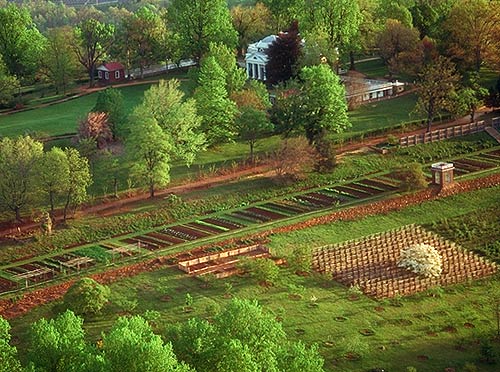
Modern English or cottage gardens tend to favor the natural look. Somewhat untidy selections of flowers and vegetables, clustered together, following naturally curved lines are prominent features. However, English gardens of the past were quite the opposite. They favored neat and tidy, fenced rows of vegetables and flowers in rectangular or geometrically arranged plots. American colonists brought this affinity for order with them and this style of gardening persisted well into the 1800s.
In these gardens, colonists cultivated a mix of flowers and vegetables from the new world and old world favorites they brought with them. They used plants for food, medicine, brewing, and beauty. Staple crops that required larger fields like maize, beans, pumpkins, wheat, and barley were typically grown separately. Sometimes people also had a small “kitchen” garden located near there door with frequently used plants.
An introduction to growing diverse pest-free fruit trees like Quince, Persimmon, Paw Paw, Medlar, & Sea Buckthorn. For more information on proper tree care get in touch with the Tree Service Pros who can advise on the best solutions for both tree removal and maintenance.
Old World
Colonists brought with them seeds, bulbs, and roots of their favorite plants to start new gardens. Here are a few of the “old world” plants that you may have seen in a colonial garden.
- Yarrow
- Daylily
- Tulips
- Cabbage
- Leeks
- Onions
- Carrots
- Peas
- Turnips
- Radishes
- Lavender
- Rosemary
- Thyme
- Parsley
New World
Colonists were also fairly quick to adopt plants from the New World, learning to cultivate corn, beans, and squash varieties that had been developed by Native Americans. They also quickly brought wildflowers like black-eyed Susans and asters into their gardens. They also adopted plants like tomatoes, potatoes, sweet potatoes, and peppers. Interestingly these South American plants passed from Native Americans to Spanish and Portuguese explorers who brought them to Europe and then to colonists who brought them to North America. Here are a few plants native to the Americas that you may have seen in a colonial garden.
- Black-eyed Susans
- Goldenrod
- Asters
- Echinacea
- Maize
- Beans
- Squash
- Pumpkins
- Tomatoes
- Potatoes
- Peppers
- Sweet Potatoes
Heritage Harvest Festival
If you want to know more about historical American gardens join Southern Exposure at this year’s Heritage Harvest Festival. This event, located at Thomas Jefferson’s Monticello celebrates his agricultural legacy as well as the contributions to American cuisine by enslaved workers. Come explore Jefferson’s 1,000 foot long vegetable garden and ornamental mountaintop landscape. Learn about organic gardening, seed-saving, southern recipes, and American history. We can’t wait to see you there!
Resources
- A Williamsburg Perspective on Colonial Gardens from The Gardens of Colonial Williamsburg, written by M. Kent Brinkley and Gordon W. Chappell
- Creating a Colonial Garden from PennState Extension
- Colonial Garden Plants from Harvard
- Planting and Herb Garden with Centuries-Old Favorites from Townsend
